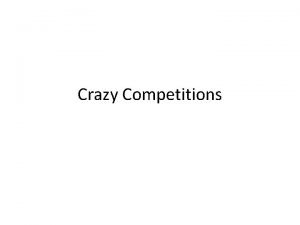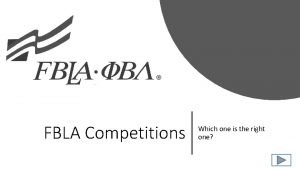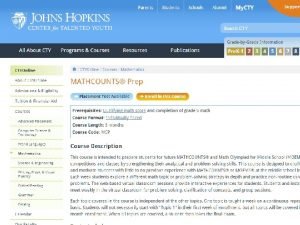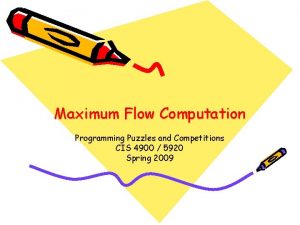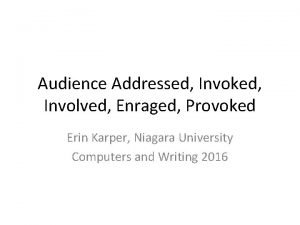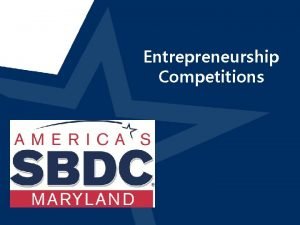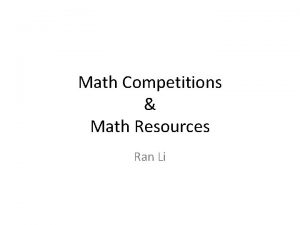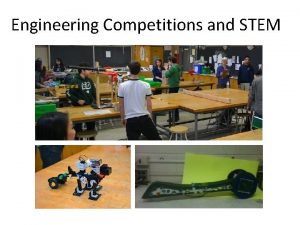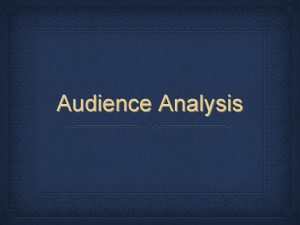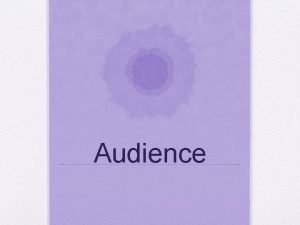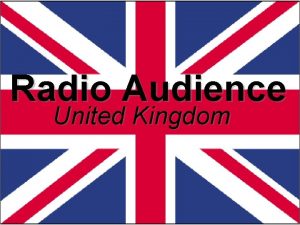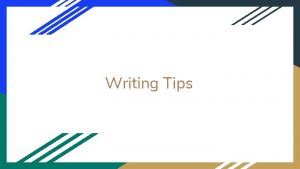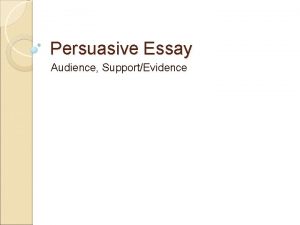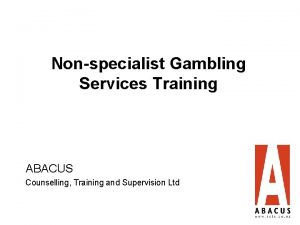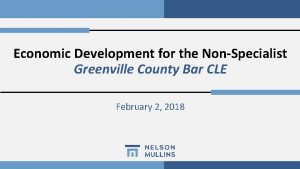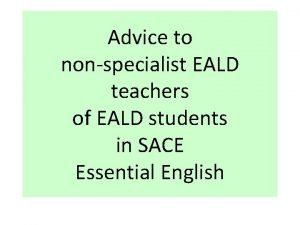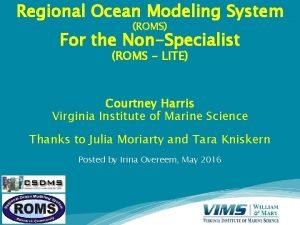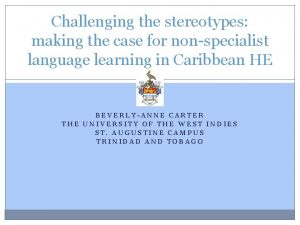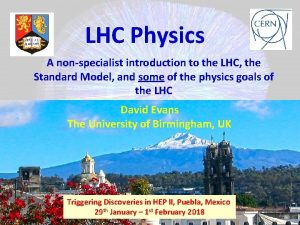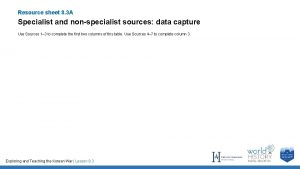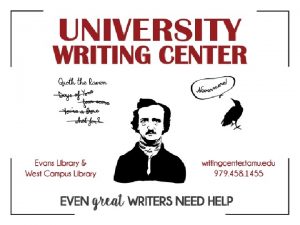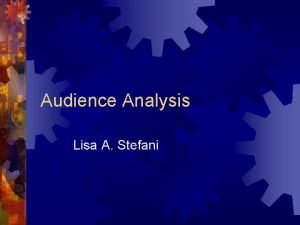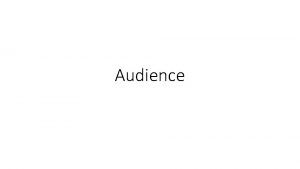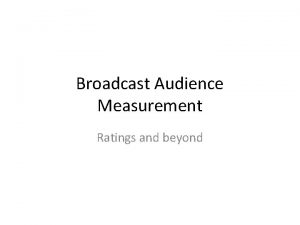Writing for a nonspecialist audience Scientific writing competitions






























- Slides: 30

Writing for a non-specialist audience: Scientific writing competitions Dr Helen Webster Writing Development Centre

The Impact Agenda Accountability and funding: RCUK Employability and transferable skills Impact Public engagement: NCL as civic university Quality: The REF

Scientific Writing Competitions § Routes to public engagement and impact: § Broadcast media (print, television, radio) § Social media § Public outreach events All of these benefit from training and support Scientific writing competitions are a good way to promote your research and your profile on a large scale and in a supported way

Major science writing competitions Europe Pub. Med Central Access to Understanding 2014 http: //europepmc. org/Science. Writing. Competition Ph. D and Pdoc, pre-selected topics, closes 9 th Dec Medical Research Council Max Perutz Award http: //www. mrc. ac. uk/Sciencesociety/Awards/index. htm MRC funded Ph. D, your own research The Wellcome Trust Science Writing Prize In association with the 'Guardian' and the 'Observer‘ http: //www. wellcome. ac. uk/Funding/Public-engagement/Science. Writing-Prize/index. htm Professional scientists, Non-professional writers (UG>Pdoc) Any area of science

Science writing competitions: What do they have in common? They all want to see § 800 words § Clear writing § Writing that is accessible to a general, non-specialist, but interested audience § Writing that goes beyond description (of the problem and of what the researchers did) § Writing that effectively communicates the contribution of the research (Why does the research matter? ) § Writing that is engaging

Starting with your audience “clear” “accessible” “engaging”

Writing for a non-specialist audience: What do science writers say? “If in doubt, assume the reader knows nothing. However, never make the mistake of assuming that the reader is stupid. The classic error in journalism is to overestimate what the reader knows and underestimate the reader's intelligence. ” Tim Radford’s Manifesto for the Simple Scribe: The 25 commandments http: //www. guardian. co. uk/science/blog/2011/jan/19/manifesto-simple -scribe-commandments-journalists

Meeting in the middle: knowledge, interest, intention Reader Scientist • What is your message? • What is your aim? • What is the interest? • What do they want? • What are their expectations/needs? • What will they do with it? The science writer’s role

The Food Chain § Academic scientific peer reviewed publishing § Stakeholder reports § Popular science books/blogs/magazines § Textbooks § Quality press (broadsheets, national news channels) § Tabloids, ‘in brief’ news sites § Online clickbait, listicles Scientists Reports Quality Lay publishing Tabloids, Clickbait

Structure

The research paper: Diagram of structure Introduction and literature review Methods Results Discussion and Conclusions

The news report: Diagram of structure The ‘inverted pyramid’ model Most important/attention-grabbing information Elaboration and detail Least important information? Return to why it’s interesting/important?

What’s the story here? § § Isn’t science/nature amazing/weird? Plucky researchers strike a blow against disease So that’s why. . now we understand. Bet you’re glad this isn’t you! § What story do you want to tell about your own research?

What makes a good opening? What did you think of those openings? The hook: § § Connection to real or possible personal experience The Unexpected, The Mysterious and The Weird Or both! An emotional reaction

A good opening paragraph: Example Studying blindness? There’s an app for that Everything is hazy; I can’t even see my glasses. I keep my eyes closed; it doesn’t seem to make much difference opening them. My hand feels clumsily around the bedside table, knocking my mobile phone to the floor, and eventually I come across my glasses. On they go, and I can see again. Those brief few seconds as I awake each morning serve as a continual reminder of how much I value my sight. Andrew Bastawrous, winner of the Max Perutz Science Writing Award 2012

The Middle Bit: finding a balance and getting to the point § How much knowledge does your reader really need to understand the research and its significance? § Where is the point in these texts where they move from setting the scene to describing the research breakthrough?

Academic Paragraph structure Topic sentence: Introduction of the paragraph’s main idea Main body in which the initial assertion is developed and explained Conclusion to be drawn from the above points Signpost word Self assessment can also develop skills which make a student more attractive to prospective employers. Employers value students with skills in self assessment because these types of skills are relevant to a wide range of employment contexts. They want graduates who can accurately assess their own competencies in performing tasks. Students who can do this are well placed to take on responsibilities and adapt readily to roles in work places. The value in developing these types of assessment can be seen to go beyond meeting immediate educational needs. Students who have developed an autonomous approach to learning are well set up for life-long learning which will continue throughout and beyond their working lives.

Language

Writing about science: Complex material simple expression “Whenever I write about science, I imagine a parrot on my shoulder saying ‘can it be said more simply’? ” Attributed to Dr Max Perutz, 1962 Nobel Prize in Chemistry, after whom the Max Perutz Award is named

‘Simply’

Avoiding Jargon “A plain English summary is a brief summary that has been written for members of the public, rather than researchers or professionals. It should be written clearly and simply, without jargon and with an explanation of any technical terms that have to be included. ” – INVOLVE Jargon is simply precise technical language which is used in an inappropriate context, in which the audience does not share the common and professional language the terms belong to.

Writing for a non-specialist audience: What do science writers say? “The shortlisted authors did a great job of using eyecatching imagery to snare our attention. ” Jenny Rohon (Judge, Max Perutz Science Writing Award 2012), in Mind the Gap blog “Some of our writers used metaphor to really good effect. But there were examples of some metaphors that were a bit off-piste. So think clearly about whether the metaphor is too tenuous, or simply extended beyond its useful life. ” Sharmila Nebhrajani

Using Imagery § Simile § Metaphor § Extended metaphor § Symbolism § “research is like a journey” § “research is a journey. As we travel, we may find we do not arrive at the destination we anticipated, or by the paths we planned” § We cannot know the destination of the Journey

The uses of metaphor: the spices in your dish § Metaphors can enable you to make a strong connection with the shared experience between you and your audience § It can create a strong ‘visual’ or concrete impression, which helps to explain the more abstract aspects of research § It makes your writing more engaging and interesting

Metaphor: leaving a sour taste § You need to be sure that both you and your audience share the same common understanding of the metaphor § Extended metaphors can break down as your meaning is twisted to fit the metaphor § Mixed metaphors are confusing § Too much metaphor can seem overly poetical and make the text too abstract

Voices – scientist, writer, reader § Scientist: Quotations from the scientists can change the pace, add a ‘human’ element, give a sense of the excitement of research § Reader: Using questions as paragraph openings can include the voice of the reader § Writer: do you want your own voice to reflect that of the scientist or that of the reader’s perspective?

Throwing the baby out with the bathwater Scientific communication – § What values and features of academic scientific writing do we want to preserve? § Which hinder scientific communication to nonacademic readers?

Europe Pub. Med Central Science Writing Competition: Comments from two judges “… we are looking for accurate, balanced representation of the research. ” Anna Kinsey (Europe PMC Engagement Manager and Access to Understanding organiser) “The best writers made complex science accessible, without patronising the reader. They drew out the ‘so what? ’ question – why should I read this, why should I care? They were frank about the unknowns and the limitations of the science. And they created energy and excitement about the research, but without hyperbole. ” Sharmila Nebhrajani

Further reading: Writing for news media § § § § Cole, P. (2008) New writing. The Guardian 25 September. Available at http: //www. guardian. co. uk/books/2008/sep/25/writing. journalism. news. Evans, H. (2000) Essential English for journalists, editors and writers. Revised edition. London: Pimlico Giles, C. (2011) What's the point of this story? Handy tips for science writers. The Guardian 9 May. Available at http: //www. guardian. co. uk/science/2011/may/09/handy-tips-science-writers. March, D. (2007) Guardian style. London: Guardian Books Parry, V. (2011) You want to know more, I know you do. The Guardian 3 May. Available at http: //www. guardian. co. uk/science/2011/may/03/secrets-good-sciencewriting. Radford, T. (2011) A manifesto for the simple scribe – my 25 commandments for journalists. The Guardian 21 January. Available at http: //www. guardian. co. uk/science/blog/2011/jan/19/manifesto-simple-scribecommandments-journalists. Vitae: the Engaging Researcher

Other routes to impact § Public outreach events
 Ross mcdermott and andrew owen travel
Ross mcdermott and andrew owen travel How do fbla competitions work
How do fbla competitions work Mathcounts preparation book
Mathcounts preparation book Flow competitions
Flow competitions Invoked audience
Invoked audience Similarities of academic writing and technical writing
Similarities of academic writing and technical writing Scientific inquiry vs scientific method
Scientific inquiry vs scientific method How is a scientific law different from a scientific theory?
How is a scientific law different from a scientific theory? Kontinuitetshantering i praktiken
Kontinuitetshantering i praktiken Novell typiska drag
Novell typiska drag Tack för att ni lyssnade bild
Tack för att ni lyssnade bild Returpilarna
Returpilarna Varför kallas perioden 1918-1939 för mellankrigstiden
Varför kallas perioden 1918-1939 för mellankrigstiden En lathund för arbete med kontinuitetshantering
En lathund för arbete med kontinuitetshantering Adressändring ideell förening
Adressändring ideell förening Personlig tidbok fylla i
Personlig tidbok fylla i Anatomi organ reproduksi
Anatomi organ reproduksi Vad är densitet
Vad är densitet Datorkunskap för nybörjare
Datorkunskap för nybörjare Tack för att ni lyssnade bild
Tack för att ni lyssnade bild Debattinlägg mall
Debattinlägg mall Autokratiskt ledarskap
Autokratiskt ledarskap Nyckelkompetenser för livslångt lärande
Nyckelkompetenser för livslångt lärande Påbyggnader för flakfordon
Påbyggnader för flakfordon Lufttryck formel
Lufttryck formel Svenskt ramverk för digital samverkan
Svenskt ramverk för digital samverkan Jag har nigit för nymånens skära text
Jag har nigit för nymånens skära text Presentera för publik crossboss
Presentera för publik crossboss Vad är ett minoritetsspråk
Vad är ett minoritetsspråk Vem räknas som jude
Vem räknas som jude Treserva lathund
Treserva lathund
